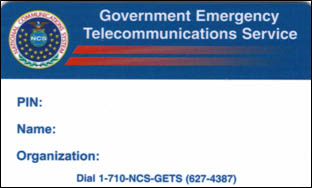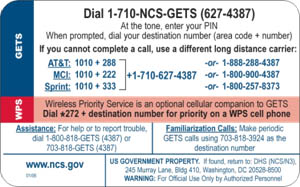- PSHSB Home
- About Us
- Advisory Committees
- Clearinghouse
- Emergency Information
- Policy Areas
- Public Safety Spectrum
- Releases
- Reporting Systems
- Summits
- Speeches and Presentations
Often times, it is necessary to either prioritize the provisioning of new communications services or prioritize the restoration of services that have been damaged or otherwise are not functioning. This is especially true in disaster situations when numerous outages may occur at once or systems become overloaded by demand. This topic introduces three major priority service programs that have been established by the Federal government in order to provide prioritized system access for designated users or to allow for prioritized installation/restoration of services. The Federal government administers these priority communications services that are provided by the wireline and wireless telecommunications carriers and are necessary to promote the nation's security and emergency preparedness (NS/EP) functions.
The three separate and distinct Federal priority communication services are:
Specific details for each of the priority service programs are given below. More information is also available on the FCC web site at http://www.fcc.gov/pshs/services/priority-services/.
The Federal Communications Commission (FCC) oversees the TSP and WPS programs. The FCC approved the use of area code 710 for GETS but does not exercise regulatory control over GETS. The National Communications System (NCS) that is located within the Department of Homeland Security's National Protection and Programs Directorate, acting as Executive Agent for the Executive Office of the President (EOP) through the Office of Science and Technology Policy (OSTP), manages daily operations of all three programs.
On November 17, 1988, the FCC issued a Report and Order adopting rules that established the TSP Program.2 The TSP Program was developed to ensure priority treatment for our Nation's most important NS/EP telecommunications services. The TSP Program comprises the regulatory, administrative, and operational framework for the priority restoration and provisioning of any qualified NS/EP telecommunications service. NS/EP services are those services used to maintain a state of readiness or to respond to and manage any event or crisis (local, national, or international) that causes or could cause injury or harm to the population, damage to or loss of property, or degrades or threatens the NS/EP posture of the U.S.
As a result of hurricanes, floods, earthquakes, and other natural or man-made disasters, telecommunications service vendors may become overwhelmed with requests for new telecommunications services and requirements to restore existing telecommunications services. The TSP Program provides service vendors with an FCC mandate for prioritizing service requests by identifying those services critical to NS/EP. A telecommunications service with a TSP assignment is assured of receiving full attention by the service vendor before a non-TSP service.
The EOP is designated as administrator of the TSP Program. The EOP, in turn, delegated its responsibilities to the Manager of the NCS. The FCC provides regulatory oversight of the TSP Program. The FCC's rules for the TSP Program are found at Appendix A to Part 64 of Title 47 of the Code of Federal Regulations (CFR).
The TSP Program rules authorize priority treatment to the following telecommunications services:
There are two general categories for TSP - Essential and Emergency, with various sub-categories and priority levels. Under the Essential category, there are four sub-categories:
The TSP Program has two components, restoration and provisioning. A restoration priority is applied to new or existing telecommunications services to ensure their restoration before any other non-TSP NS/EP telecommunications services (apart from critical, internal network systems). Priority restoration is necessary because interruptions of telecommunications services may have a serious, adverse effect on the supported NS/EP functions.
A provisioning priority is obtained to facilitate priority installation of new telecommunications services. Provisioning on a priority basis becomes necessary when an NS/EP user has an urgent requirement for a new telecommunications service that must be installed immediately (e.g., an emergency) or by a specific due date that can be met only by a shorter than standard or expedited service vendor provisioning time frame.
Organizations that require telecommunications services to support NS/EP missions can qualify for the TSP Program. Non-Federal users must have a Federal sponsor. Non-Federal users are state, tribal, and local government agencies such as state EOCs, police, fire, EMS, Public Safety Answering Points (PSAPs) and 911 call centers; foreign governments within U.S. jurisdiction such as an embassy; and private industry entities such as utilities and hospitals.
TSP enrollment rates, are, generally, set by state tariffs. They average approximately $100 for one-time enrollment of a circuit and $3 per month for an enrolled circuit.
To find out more about the TSP Program, you may contact the FCC or the NCS TSP Program Office:
FCC TSP Contacts |
|||
| Burnley, Kenneth | 202.418.0664 | Kenneth.Burnley@fcc.gov | |
| Kelly, Jane | 202.418.2832 | Jane.Kelly@fcc.gov | |
| Manuel, Allan | 202.418.1164 | Allan.Manuel@fcc.gov | |
| FCC TSP e-mail | tspinfo@fcc.gov | ||
| FCC TSP website | http://www.fcc.gov/pshs/services/priority-services/ | ||
NCS TSP Program Office |
|||
| NCS Toll Free TSP number | 866.NCS.CALL (866-627-2255) | ||
| NCS DC Metro TSP number | 703.760.2255 | ||
| NCS TSP e-mail | tsp@dhs.gov | ||
| NCS TSP website | http://tsp.ncs.gov/ | ||
On July 13, 2000, the FCC issued a Report and Order adopting rules permitting wireless service providers to offer Priority Access Service (now WPS).3 The WPS was developed to provide end-to-end nationwide wireless priority communications capability to NS/EP personnel during natural or man-made disasters or emergencies that cause congestion or outages in the PSTN. WPS is available in Code Division Multiple Access (CDMA), Global System for Mobile Communications (GSM), and iDEN (Integrated Digital Enhanced Network) networks.
In the event of congestion in the wireless network, an emergency call made by dialing prefix *272 on a wireless device enabled with WPS before the destination number gives the WPS authorized caller priority wireless access before non-subscribers (i.e., in the access channel queue). WPS calls do not preempt calls in progress.
WPS is complementary to, and can be most effective when used in conjunction with GETS to ensure a high probability of call completion in both the wireless and wireline portions of the PSTN.
The FCC provides regulatory oversight of the WPS Program. The FCC's rules for the WPS Program are found at Appendix B to Part 64 of Title 47 of the CFR.
There are five priority levels for WPS:
Only persons with NS/EP missions may use WPS. These users can range from senior members of the Presidential administration, to emergency managers and fire and police chiefs at the local level, to critical technicians in wireline and wireless carriers, banking, nuclear facilities, and other vital national infrastructure sectors.
There is a one-time $10 activation fee for organizations requesting WPS services for authorized members of their respective organization; monthly fees amount to $4.50 with each call billed at $.75 per minute. These charges for WPS are in addition to a user's basic calling plan.
| FCC WPS Contacts | |||
| Burnley, Kenneth | 202.418.0664 | Kenneth.Burnley@fcc.gov | |
| Kelly, Jane | 202.418.2832 | Jane.Kelly@fcc.gov | |
| Manuel, Allan | 202.418.1164 | Allan.Manuel@fcc.gov | |
| FCC TSP e-mail | tspinfo@fcc.gov | ||
| FCC TSP website | http://www.fcc.gov/pshs/services/priority-services/ | ||
NCS WPS Program Office |
|
| NCS Toll Free WPS number | 866.NCS.CALL (866-627-2255) |
| NCS DC Metro WPS number | 703.760.2255 |
| NCS WPS e-mail | wps@ncs.gov |
| NCS WPS website | http://wps.ncs.gov |
GETS is a nationwide priority telecommunications service for persons with an NS/EP mission who need to communicate in a crisis, disaster, or other emergency when the probability of completing a phone call over the Public Switched Telephone Network (PSTN) has significantly decreased because of network capacity (e.g., congestion). In such circumstances, GETS allows priority call processing and routing for authorized NS/EP users. There are no priority levels within GETS, and a GETS call does not preempt public calls over the PSTN.
The EOP tasked the NCS with developing GETS to provide NS/EP users emergency access and specialized processing over local and long distance networks (with priority only in U.S.). The FCC approved the use of area code 710 for GETS. The NCS manages the GETS Program.
GETS is accessed through a universal number (1.710.NCS.GETS) and a personal identification number (PIN). GETS is complementary to, and can be most effective when used in conjunction with, WPS to ensure a high probability of call completion in both the wireless and wireline portions of the PSTN.
Notable GETS features include:
In addition to the PSTN, which is the backbone for GETS (because of its survivability, ease of use, availability, robustness, and reliability), GETS can also be accessed through the Defense Switched Network, the Diplomatic Telecommunications Service, and the Federal Technology Service.
GETS is available to Federal, state, local, and tribal government, industry, and non- governmental organization personnel in performing their NS/EP missions. These missions include:


In general, user organizations are charged seven to ten cents per minute of use by a GETS authorized user when making a domestic call; pre-arranged GETS service for international calls is billed at commercial rates.
PSHSB is currently conducting outreach activities with respect to each of the Priority Telecommunications Service programs. In particular, PSHSB has been supporting outreach efforts to increase participation in each of these programs through activities and the efforts of its Public Communications Operations and Outreach Division (PCOOD). These services are extremely important in emergency situations and for NS/EP mission performance. All Federal departments and agencies, along with qualified, state, local, and tribal government, industry, and non-governmental organizations should review their telecommunications needs to determine if any of these critical capabilities would assist them in performing their NS/EP missions.
| FCC GETS Contacts | |||
| Burnley, Kenneth | 202.418.0664 | Kenneth.Burnley@fcc.gov | |
| Kelly, Jane | 202.418.2832 | Jane.Kelly@fcc.gov | |
| Manuel, Allan | 202.418.1164 | Allan.Manuel@fcc.gov | |
| FCC TSP e-mail | tspinfo@fcc.gov | ||
| FCC TSP website | http://www.fcc.gov/pshs/services/priority-services/ | ||
| NCS GETS Program Office | |||
| NCS Toll Free GETS number | 866.NCS.CALL (866-627-2255) | ||
| NCS DC Metro GETS number | 703.760.2255 | ||
| NCS GETS e-mail | gets@ncs.gov or gwids@saic.com | ||
| NCS GETS website | http://gets.ncs.gov/index.html | ||
1 This Tech Topic is coauthored with Allan Manuel, Esq., Associate Division Chief in the Public Communications Operations and Outreach Division of the Public Safety and Homeland Security Bureau. Allan is a subject matter expert regarding TSP, WPS, and GETS services and is the agency's primary point of contact for issues relating to these services. Allan's efforts on these programs and his assistance on this Tech Topic are sincerely appreciated. Allan may be reached at the telephone number and email listed in the topic.
2 See National Security Emergency Preparedness Telecommunications Service Priority System, Report and Order, 3 FCC Rcd 6650 (1988).
3 FCC Rcd 6650 (1988).